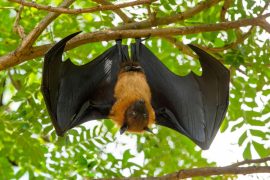Bryophytes (Mosses, Liverworts, and Hornworts)
Alternative titles: Petridophyta

The bryophytes are a group of non-vascular plants that exist on land. Terrestrial refers to their growing on land, whereas nonvascular signifies they lack food and water bearing channels. There are three main categories of this group: mosses (Bryophyta), liverworts (Marchantiophyta), and hornworts (Anthocerotophyta).
These incredible bryophyte plants can be found all over the world, including Antarctica and the Arctic! Despite their preference for more humid climates and inability to tolerate extreme arid conditions, these plants can also be found in moist pockets of the desert and near the intertidal zone. Bryophytes are essential to the health of ecosystems wherever they grow. They play a key role in soil formation, maintaining soil moisture, and nutrient cycling.
What Is a Bryophyte?
Bryophytes have two attributes in common - they are terrestrial and they do not have vascular systems. What exactly does this mean? The bryophytes represent one of three groups of plants, including the tracheophytes, the thallophytes, and the bryophytes.
- Tracheophytes are vascular plants with lignin and vascular tissue. Lignon is a polymer that gives plants structure and allows them to grow tall. Xylem and phloem are the vascular systems that transport water and nutrients throughout the plant. Tracheophytes are also classified as terrestrials, or land plants. Trees, ferns, grasses, and flowering plants are all examples of tracheophytes.
- In contrast, thallophytes require a fully aquatic environment to survive, despite being nonvascular as well. These include algae, seaweeds, kelp, and diatoms.
- Between these two groups lie the bryophytes, which occupy the same terrestrial ecosystem as tracheophytes, but lack the vascular vessels as thallophytes.
Characteristics of Bryophytes
There are a few other characteristics that are common to all bryophytes besides being terrestrial and nonvascular.
- Small Stature: Without the lignin that evolved with vascular plants, bryophytes are ground-ridden, meaning that they don’t have the structural ability to grow upwards. Because of this, most bryophytes cover rocks, logs, and the ground like carpets.
- Rhizoids: These are tiny hair-like structures that serve as anchors for the plant. Despite the fact that they often look like roots, bryophytes are nonvascular. Rhizoids do not conduct nutrients or water.
Bryophyte Nutrition
By using the chlorophyll in their chloroplasts, bryophytes are photosynthetic plants that produce their own food. In contrast, the way they absorb minerals and water differs greatly from that of their vascular cousins.
Water-Absorbing Leaves
Bryophytes, which lack roots and stems, absorb water and minerals directly through their leaves. Their overlapping leaves and abundant rhizoids increase the efficiency of absorption. These nonvascular plants, however, have no means of retaining moisture. The tendency of an organism’s water content to change with its environment is called poikilohydric.
Growth Cycles Tied to Water Availability
Poikilohydric organisms require water to grow. Therefore, if there is no moisture in their environment, they will enter a state called desiccation. Surprisingly, if a bryophyte is in a desiccated state, it can still survive. Water will rehydrate the plant and enable it to begin growing again once the ecosystem is re-hydrated.

Life Cycle and Reproduction
Bryophytes have a life cycle consisting of two distinct stages or a succession of generations, each with a different shape. These are the sporophyte and gametophyte generations, each stage being named for what they produce. The sporophyte generation, for example, produces spores that develop into new plants. Meanwhile, the gametophyte generation consists of the adult plants that produce haploid cells that fuse together to make viable spores.
Spore Develops into the Gametophyte
Initially, a spore germinates to form a protonema, which is like a seedling in a flowering plant. Upon reaching the mature gametophyte stage, the plant moves to a more elaborate, leafy state.
Gametophyte Releases Gametes
The gametophyte can produce either male or female sex organs, with some species being able to produce both. Archegonium are female organs that contain a single egg. Antheridiums, or male organs, are full of cells that produce sperm. In the mature archegonia, sperm are attracted to the egg by a fluid, and the antheridia release the sperm. Sporophytes begin to develop following fertilization.
Sporophyte Releases Spores
In turn, the fertilized zygote will develop into a diploid sporophyte. During its maturation, however, it is dependent on the gametophyte for nutrition. As the sporophyte develops, it becomes a long stalk, topped by a sporangium. The rupture of this structure allows for the dispersal of spores, and the cycle begins again.
Bryophyte Evolution & Classification
Thallophytes were the first plants on earth. This water-bound, floating algae is often just a single cell thick, and it absorbs water and nutrients directly into its cells. About 400-450 million years ago, plants began to move onto land, leading to the evolution of embryophytes. Two important traits of green algae emerged at different times: a waxy cuticle and a gametangia. In both cases, the development protects the plants from drying out too soon and allows them to live in terrestrial ecosystems.
Initially, these thallophyte plants needed to stay relatively close to water. Having a whole new world to expand into, new, drought-tolerant species began to evolve. Among the descendants of these early embryophytes are liverworts, hornworts, and mosses today.
While all three groups are bryophytes, they belong to different phyla. Molecules are classified as Bryophyta, liverworts as Marchantiophyta, and hornworts as Anthocerotophyta.
Mosses (Bryophyta)
A moss is often described as being soft and fluffy because its leaves and stems look distinct. Sporophytes develop at the end of a long stem (called a seta) that is topped by spore-producing capsules. The leaves of mosses are spirally arranged along the stem, with a vein running through the middle of every leaf.
Interestingly, moss sporophytes have stomata on the sporangium. The process of transpiration is facilitated by stomata, which are typically located on the leaves and stems of tracheophytes. According to one theory, stomata in bryophytes are responsible for helping the sporangium dry out and prepare for spore release.
Moss is not the same thing as lichen, which is a combination of at least two organisms - fungi and algae.
Growth Pattern
Moss are divided into two types based on their growth habits: acrocarps and pleurocarps. Acrocarps have vertical stems, producing sporangia at the ends. Pleurocarps, on the other hand, have a creeping, horizontal growth pattern. Sporophytes extend laterally from the stem sides.
Habitat
Moss lives in a variety of habitats around the world. Moss is prevalent in rainforests, wetlands, and alpine ecosystems, but you can also find it nestled in brick walls and in sidewalk cracks in urban and suburban areas. A few species can even live in arctic and desert climates.
Distribution and Diversity
Among the bryophytes, moses have the greatest diversity, with around 15,000 species. Moss species are further divided into four categories within the Bryophyta phylum:
- Sphagnopsida – peat or sphagnum moss
- Andreaopsida – rock and lantern moss
- Polytrichopsida – nematodontous moss
- Bryopsida – arthrodontous moss
Even though some types of moss are more common than others, all four kinds can be found around the world. Comparatively speaking, temperate broadleaf forests, boreal forests, and tundra tend to have the highest diversity of mosses.
Life Cycle Differences
Mosses have the ability to reproduce asexually, which usually happens via vegetative reproduction. This occurs when part of the plant is separated and becomes its own individual. Breeding can also be accomplished through 'brood bodies', which are special groups of cells capable of developing into plants.
Examples of Moss
- Polytrichum commune (common haircap moss) grows throughout the Western Hemisphere. From above, the light-green spiked leaves of this acrocarpus species resemble a star.
- Laucarobryum glaucum (Pincusion Moss) is a species of acrocarpus, but with a dwarf structure, it lacks height. Rather, it forms clumps of green to form domes.

Liverworts
Compared to moss, liverworts grow much closer to the ground, hugging the surface with large, flat rubbery leaves. Their sporophyte form appears as either a rubbery, green ‘flower’ or like a globe on a stem, depending on the growth pattern.
Growth patterns
Liverworts have two primary growth patterns: leafy and thalloid. Leafy liverworts constitute the majority of the phyla. Appearing similar to moss, their leaves are arranged in two rows (as opposed to spirals) and lack the center vein. The remainder of liverworts are thallus. Thalloid liverworts grow horizontally and have wide, flat leaves that are rubbery. Leafy liverworts more commonly sport the globe spore capsule while thalloid liverworts the flower-like capsule.
Distribution and Diversity
Slightly less diverse than moss, there are between 6,000-8,000 species of liverwort. Two primary classes of liverworts are distinguished by the growth pattern. Thallus liverworts are grouped in the Marchtiopsida class, and leafy liverworts represent the Jungermanniopsida class. Jungermanniopsida includes upwards of 80% of liverworts with an enormous diversity in appearance and habitat preference. While liverworts can be found worldwide, they are more common in the tropics. Like most bryophytes they are resilient and 25 species can even be found in Antarctica!
Habitat
Common in tropical habitats, the different classes of liverworts do display slightly different preferences for substrate. Thallus liverworts (Marchtiopsida) prefer moist soil or rocks while the leafy variety branch out onto tree trunks and damp wood.

Life Cycle Differences
While liverworts can follow the typical life cycle of bryophytes, most can reproduce asexually using a gemmae. Held in gemma cups, these disks of tissue are produced from the gametophyte. Rainfall distributes them into the ecosystem, and they begin developing into another gametophyte.
Examples of Liverworts
- Snakeskin Liverwort (Conocephalum salebrosum) has thallus that are reminiscent of large overlapping straps. Air pores cover the surface of the thallus, giving it the appearance of snakeskin. This species is common of moist soil throughout North America.
- Variable-leaved Crestwort (Lophocolea heterophylla) is a leafy liverwort that develops a carpet of leafy shoots. Greenish-yellow in color, the leaves can often have a slightly translucent appearance.
Hornworts
Hornworts look fairly similar to liverworts in the gametophyte stage, and they are generally blue-green in color. However, the sporophyte generation gives them their name. A distinctive long, thin, needle-like sporangium looks like a horn. These bryophytes differ from all other plants as each cell only contains a single large chloroplast. Similar to moss, hornworts also have stomata on the sporophyte generation.
Growth Pattern
As gametophytes, hornworts are similar to a liverwort’s thallus growth form. Wrinkled or lobed sheets creep over the substrate. Depending on the genus, hornworts grow in either a branching or circular pattern. However, hornworts show no differentiation among cells throughout the gametophyte generation.
Distribution and Diversity
The least diverse phyla of bryophytes, there are only about 100-300 species of hornworts. The largest genus of hornworts, Anthoceros, can be found worldwide, but many of the other genera can only be found in tropical ecosystems.
Habitat
Showing preference for warmer climates, hornworts are usually found in tropical and warm temperate ecosystems.
Examples of Hornworts
- Field Hornwort (Anthoceros agrestis) is a member of the largest genus of hornworts. The thallus looks like a thin dark green disk, and the sporophyte is a lighter green stalk.
- Bighorn Hornwort (Megaceros aenigmaticus) forms very thin dark green sheets on wet rocks. The thallus is lobed with toothed edges. This species rarely produces reproductive structures.

Ecological Impact
Bryophytes act as the humble backbone to many ecosystems. Throughout their lifecycles, they play an important role in soil formation, maintaining soil moisture, and recycling nutrients. The presence and diversity of bryophytes in an ecosystem can inform the status of nutrient cycling.
Beyond their impact on general ecology, species of bryophytes have proven to be beneficial to humans. For example, peat or sphagnum moss is critical for gardeners trying to improve water retention in the soil. Because of its density, peat moss is also used for energy production and as an impressive substitute for cotton bandages during World War I. Famously, Scotch whiskey relies on sphagnum moss to create the characteristic smoky flavor.
The uses of bryophytes don’t stop there. In Sweden, a species of moss was discovered to remove arsenic from water. Even artists have begun using moss as a medium of inspiration.
Whether it be mosses, liverworts, or hornworts, all bryophytes have developed incredible adaptations to survive in all corners of the planet. Working to keep ecosystems healthy, these inconspicuous plants have been under our feet all along.
families in bryophytes
Jump to families starting with:
News coming your way



































